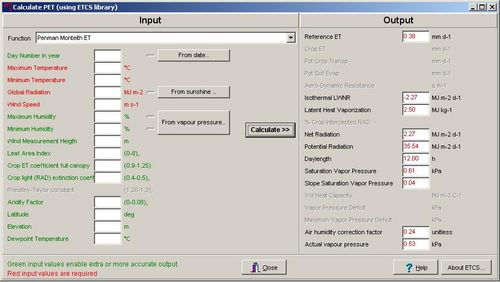[edit]2.3. Selection of a reference period.
Peter Hoefsloot, WMO publications [edit]Introduction
In order to evaluate crop growth, historical data need to be present for the area under study. In different countries, datasets differ substantially. Some countries have a long record even dating back into the years 1800. Some countries have experienced poverty, war or other disruptions in record taking and keeping and do hardly have any records. WMO (The World Meteorological Organization) has initiated many so-called data rescue projects. These projects aim at gathering (agro)meteorological data and entering them into databases. See an example of one of these projects in South East Asia: http://www.vsamp.com/resume/publications/Page_et_al_2004.pdf
The reference period should at least reflect the latest 30-year climatological periods defined by WMO (1961-1990 or 1970-2000). If possible the reference period could be extended to the main meteorological instrumented period (1870-2000), although one should be aware of climatological differences in such a long period.
On data a distinction should be made between data that remain fairly stable between years (more or less constant data) and data that have large variations from year to year (data with yearly fluctuations)
[edit]Data that may be considered constant for the reference period.
- Crops (name, varieties and areas)
- Cycle lengths
- Phenological stages
- Crop coefficients.
- Soil water holding capacity
- For irrigated crops : bund height.
[edit]Data that fluctuate strongly from year to year
- Yields and production data per administrative unit.
- Rainfall
- Parameters to calculate the potential evapotranspiration (ET0). Generally one needs data on:
- Wind speed, e.g. at 2 or 10 meters above ground level
- Temperatures, e.g. daily minimum, maximum, average..
- Humidity, relative humidity or vapour pressure
- Radiation, e.g. sunshine hours, radiation, day length etc…
The ET0 can be calculated in many ways. AgrometShell provides a possibility to check whether input data qualify for the calculation of the ET0.
ET0 calculation check in AgrometShell with function ‘’Tools-Potential ET-Manual’’  [edit]
[edit]How to obtain data for the reference period
Data for the reference period can be found at various sources inside and outside the country of region of study.
- Wheather data should generally be obtained from the National Meteorological Service, WMO and FAO. Global datasets are maintained by various organisations like National Oceanic and Atmosferic Administration (NOAA) and the European Centre for Medium-Range Weather Forecasts (ECMWF)
- Crop and soil data can usually be fond at the Ministry of Agriculture and/or the agricultural extension services or FAO. The FAO Soil Map of the World is often used as a basis for the Water Holding Capacity (WHC). A global WHC dataset can be found here: http://www.daac.ornl.gov/SOILS/guides/Webb.html
A general recipe on data availability cannot be given. Some research on the internet and through national and international bodies will be necessary.

| CM Box User Guide | Main Page | About | Special pages | Log in |
Printable version | Disclaimer | Privacy policy |